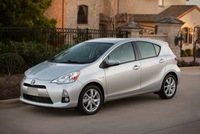2012 Toyota Prius c Review and Road Test by Steve Purdy +VIDEO
Toyota Buyers Guide - 1997-2012 Specs, Comparisons and Prices
2012 TOYOTA PRIUS c - A New Family Member
By Steve Purdy
TheAutoChannel.com
Detroit Bureau
You may know that Toyota’s hybrid Prius, now in its third generation, owns fully half the hybrid/electric car market in the U.S. Early adopters, tree huggers, technology lovers adopted Prius right from its Japanese birth in 1997. Coming to the U.S. in 2000, Prius has been so successful that Toyota is now making a whole family out of it – adding a larger version last year, now adding a smaller one and a plug-in. We’re in Florida this week evaluating the new little Prius c – ‘c’ for city. They insist on the lower case ‘c’ to reflect the diminutive size of the car, I suppose.
 |
With electric water pump and electric power steering this new version of the 1.5-liter 4-cylinder engine is “beltless,” reducing maintenance costs over the long run. It makes just 73 horsepower and 82 pound-feet of torque but is supplemented by 60 horsepower worth of electric motor power. Electric motors, as you probably know, generate their torque right from zero rpm and this one grinds out 125 pound-feet. So, the electric power mitigates a bit the tepidness of the Atkinson Cycle. Still, zero-to-60mph time is a leisurely 11 seconds with the CVT.
Rated at 53-mpg in the city, 46 on the highway and 50-mpg combined, it is the highest mileage car on the market without a plug, they insist. If you have a light foot, pay attention to the car’s tutorials and have good conditions you might do even better. In creepy-crawly traffic you have the advantage of being able to keep it on electric power a good deal of the time, up to about 25 mph. Prius c only has a 9.5-gallon gas tank, but 50-mpg gives a range over 400 miles.
As with most hybrid powertrains regenerative braking is part of the package. One of the many readouts on the dash will tell you how efficient is your braking. I wondered about the criteria, thinking that perhaps the harder one brakes the more energy goes back into the system. Not so, say the Toyota engineers. The batteries can only absorb the energy at a certain rate so gentle braking is more efficient.
With a starting price of just $18,950 it is the least costly way of getting into a super-efficient hybrid sedan. With four levels of content and trim the Prius c maxes out around $24,000. The base car, called Prius c One, is reasonably equipped with automatic climate control, 3.5-inch multi-function display, tilt/telescopic steering wheel with audio, climate, phone and information controls, remote keyless entry, power windows, and 9 airbags. The standard audio system has AM/FM/CD and MP3/WMA capabilities with iPod and USB port and Bluetooth, and only four speakers.
Watch the Toyota Prius c interview
Other trim levels – Two, Three and Four – add a bit of content each, like upgraded audio, cruise control, navigation, Toyota’s Entune with 6.1-inch screen, satellite radio, smart key, alloy wheels, heated seats and power moonroof. Fully loaded you’ll still not mistake this for a premium little car.
Climbing into the cockpit it is apparent right away that we’re in an economy car. No superfluous adornments or fancy materials imply anything other than what it is. Dash design is pleasant and driver-focused with instrument cluster high on the dash and to the right, making it easy to glance from the road to the instruments. The rest of the controls and information screen are high on the center stack – again, making it easy to use. Readouts, graphs and displays will tell you about your driving efficiency for many angles.
Seats are comfortable and fairly generous for a subcompact car. The rear seat back folds but only as a unit in the Prius c One. Each side must be released individually before it folds. That would be a serious annoyance to have to release each side of the seat separately. The other trim levels get a 60/40 split rear seat back.
When we think that this is a mighty small car we’re amazed at the room inside as well as the easy ingress and egress. I’m a guy of mighty girth and getting into the rear seats of compact cars is not one of my favorite things to do. This one was easier than most in that regard, though once inside I could feel the top of my balding head flirting with the headliner. With the rear seat back folded we have over 17 cubic-feet of cargo space.
The battery pack and all hybrid-related components are warranted for 10 years or 150,000 miles while the rest of the car gets only 3 years or 36,000 miles. The powertrain is covered for 5 years or 60,000 miles.
We had a short drive in the Prius c here in Delray Beach, Florida. Some journalists were grousing about not getting some serious curvy road time or high-speed opportunities but after all, that’s not what this car is all about. The Prius c’s forte is buzzing around town with an occasional trip. And it does that well. Handling, performance and driving dynamics are about what you’d expect from an economy car – nothing to write home about but entirely pleasant and competent.
The made-in-Japan Prius c is expected at dealers in mid March.
© Steve Purdy, Shunpiker Productions, All Rights Reserved



